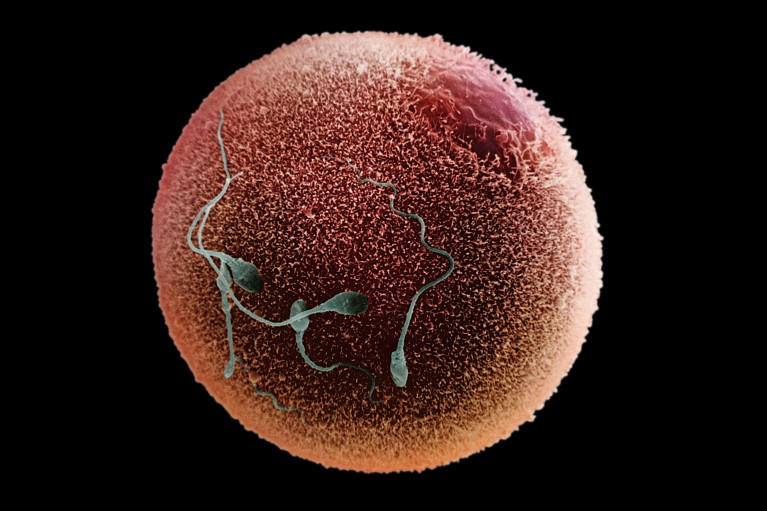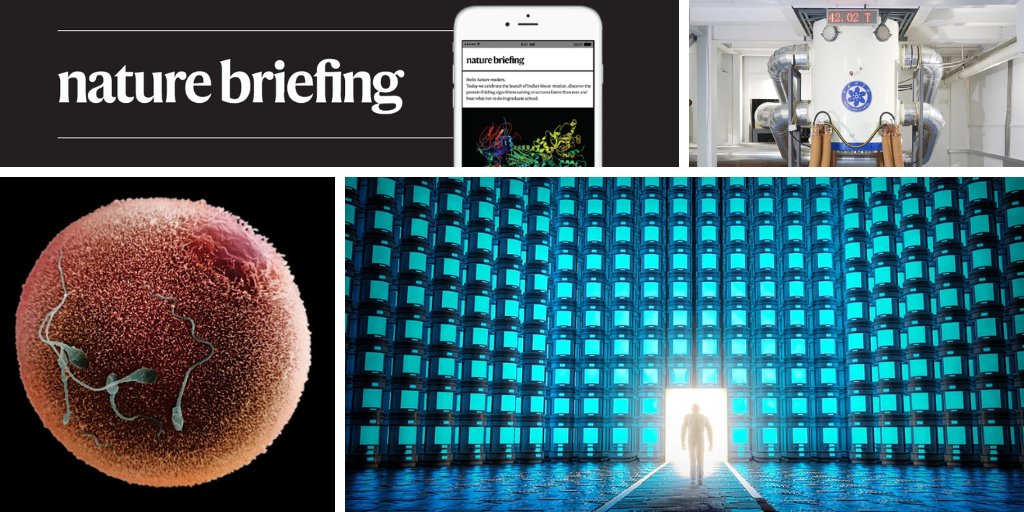Hello
Nature
readers, would you like to get this Briefing in your inbox free every day?
Sign up here
.

A trio of proteins helps a sperm (artificially coloured) to dock to an egg.
Credit: D. Phillips/Science Photo Library
Researchers have identified three proteins that work together as matchmakers between sperm and egg cells. They used the artificial-intelligence tool AlphaFold to predict the interactions between proteins of sperm cells. It predicted that
three such proteins form a complex
, which creates a place for an egg protein to bind. “It’s not the old concept of having a key and a lock to open the door anymore,” says reproductive biologist Enrica Bianchi. “It’s more complicated.”
Reference:
Cell
paper
A magnet at the Steady High Magnetic Field Facility (SHMFF) in China has sustained a
steady magnetic field of 42.02 tesla, which is more than 800,000 times stronger than Earth’s
— making it the world’s most powerful resistive magnet. High-field magnets are handy tools for uncovering hidden properties of advanced materials, such as superconductors, and could offer researchers glimpses of entirely new physical phenomena. The drawback is the power these mammoth magnets consume: the SHMFF’s magnet used 32.3 megawatts of electricity to produce its record-breaking field. “You’ve got to have a very good science case to justify that resource,” says condensed-matter physicist Alexander Eaton.
“We vaccinated for smallpox and eradicated it. But look, something came out of that: monkeypox,” said Uganda’s health minister, Jane Ruth Aceng, in August. Smallpox and mpox are closely related diseases — having immunity to one boosts immunity to the other.
Once smallpox was eradicated, and the vaccination campaigns halted, population immunity to both diseases waned
. Researchers were aware of this risk, but at the time, mpox wasn’t seen as a big enough threat. Now, African nations are scrambling to rebuild the medical expertise to diagnose and treat mpox outbreaks; skills that disappeared along with the vaccines.
Features & opinion
Chemist turned science journalist Victoria Atkinson is championing the humble coffee break.
Stepping out of the lab for a moment, she writes, is far from a waste of time
. In fact, her breaks with colleagues during her master’s and PhD was where the real learning began — helping her to pick up the lab tips and tricks she didn’t get in the classroom.
An 89-year-old considers what it means to be home as she watches her life play before her eyes in
the latest short story for
Nature
’s Futures
series.
A type of binary-system called a microquasar has been found to be firing out γ-rays at high energy-levels, evidence that it might be
a long-theorized natural particle-accelerator known as a PeVatron.
These objects are thought to be a source of galactic cosmic rays, the origins of which are currently a mystery. “Supernova explosions have been good candidates for accelerating these cosmic rays and people haven’t really considered microquasars, at least not recently,” says astrophysicist Jamie Holder, who wrote about the paper in the accompanying
Nature News & Views
article. “So this is kind of revitalizing this idea that maybe these types of systems could contribute as well.”
Nature Podcast | 30 min listen
Subscribe to the
Nature Podcast
on Apple Podcasts
,
Spotify
or
YouTube Music
, or use the
RSS feed
.
Today Leif Penguinson is enjoying the autumn colours of
Patagonia National Park
in Chile.
Can you find the penguin
?
The answer will be in Monday’s e-mail, all thanks to Briefing photo editor and penguin wrangler Tom Houghton.
While I pop off on a short holiday, you will be in the capable hands of associate editor Jacob Smith. Please make him feel welcome by sending your feedback to
[email protected]
.
Flora Graham, senior editor, Nature Briefing
With contributions by Jacob Smith and Sarah Tomlin
Want more? Sign up to our other free Nature Briefing newsletters:
•
Nature Briefing: Careers
— insights, advice and award-winning journalism to help you optimize your working life
•
Nature Briefing: Microbiology
— the most abundant living entities on our planet — microorganisms — and the role they play in health, the environment and food systems
•
Nature Briefing: Anthropocene
— climate change, biodiversity, sustainability and geoengineering
•
Nature Briefing: AI & Robotics
— 100% written by humans, of course
•
Nature Briefing: Cancer
— a weekly newsletter written with cancer researchers in mind
•
Nature Briefing: Translational Research
— covers biotechnology, drug discovery and pharma


